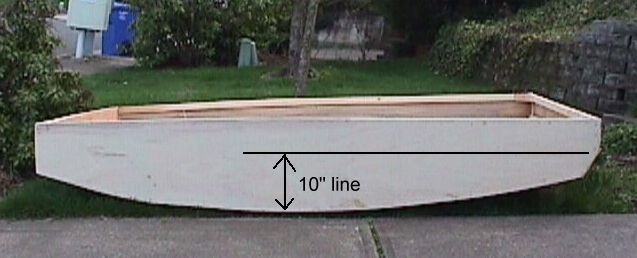How To Cut The Bow Angle
If you have been around boat plans for a while, you might have noticed that our defined hull shape is measured a bit differently than most of the plans out there. Most sailboat plans start from a straight edge on the top of the panel, then have 2 measurements down. The first is for the curve of the gunnel, and the second is for the rocker curve. Since our boat has a variable height and open gunnel shape that is determined by the builder, our side panel is measured from the bottom up. That way you can use the same dimensions for drawing the rocker, no matter what height or shape of your gunnel & side panel.
There is only one slight problem, if you are building a hull that is anything other than 18" high, (most build 16" high hulls) then the overall length is going to be different than 8', and you have to understand how to measure, mark and cut the proper bow angle. To understand this, lets look at making an 11" high hull.

The shaded area of this sketch shows a standard 18" high hull. The white area shows an 11" high hull, which is shorter in length to make it class legal.

To properly measure and mark the bow angle, you simply measure where an 18" high hull would have the end of it's bow, and then mark down from there.
If the piece of wood you are using for your side panel is not tall enough, you can clamp another board behind your side panel so that you can measure 18" up, and and mark from there.
Hulls Taller than 18" (and longer than 8')
Since bow angle is fixed and must be the same for all boats, if you want to make a hull taller than 18", then to maintain the correct bow angle, you will need to splice on more plywood in the bow area. This will make the hull slightly longer than 8 feet.

Altering the bow transom
Since the bow transom is required to be flat, and the required hull is only 10" tall, as soon as you go above that 10" line, you can alter the bow transom as long as it stays inside the bow angle.
The snub nosed duck pictured to the right is a good example. As soon as the bow transom went above the 10" line, the transom turned towards the inside of the boat and went straight up. Anything above that line, and inside the bow angle, is considered "inside the boat", just like a cabin or decking would be.
NOTE: You can NOT extend the outside (forward) of the bow angle. If you do extend outside of the bow angle, then that portion would violate the external flotation rule, and not be allowed.
